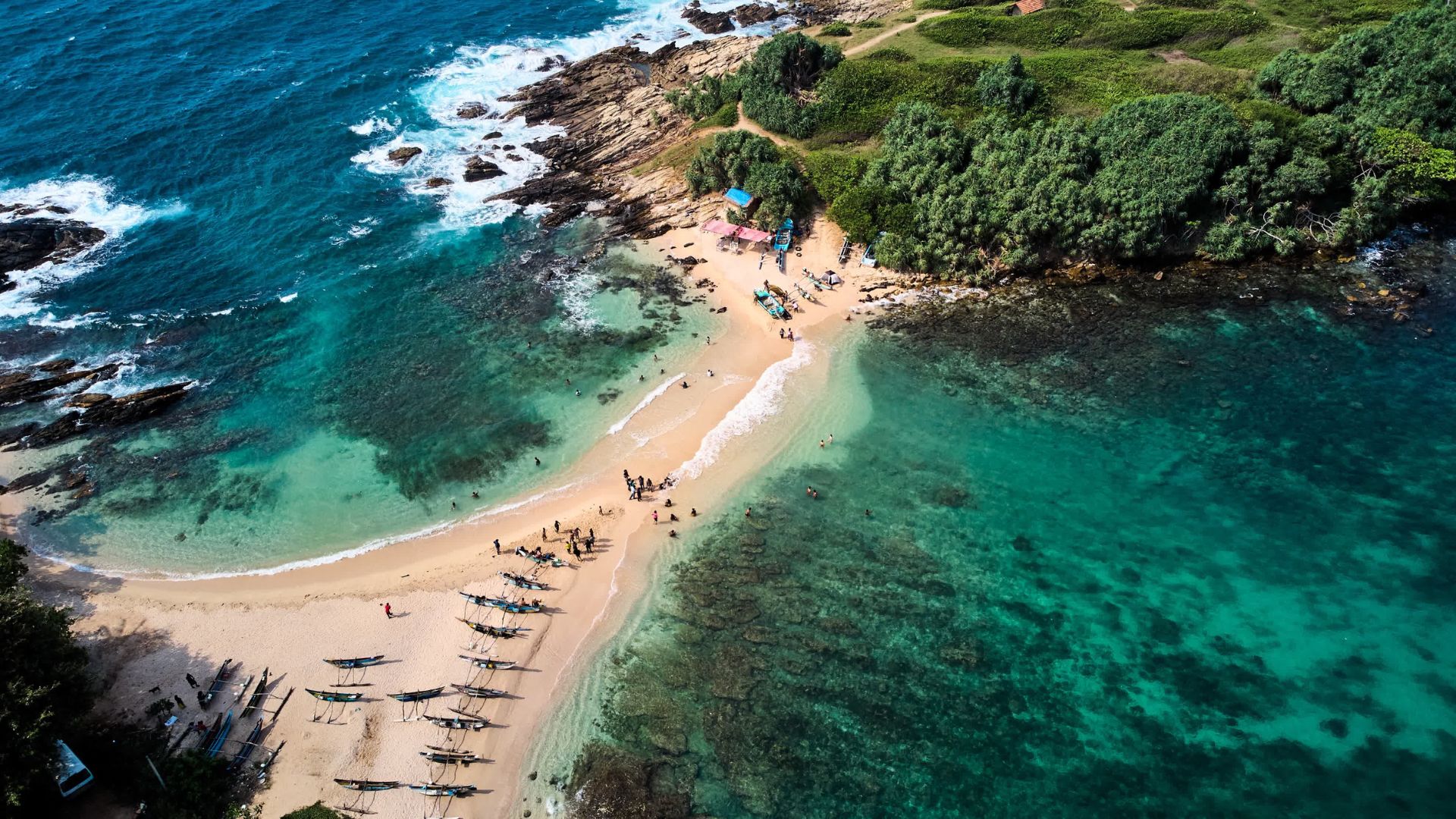
Sri Lanka
Sri Lanka, often called the Pearl of the Indian Ocean, is a country where golden beaches, ancient temples, and lush tea plantations come together in perfect harmony. Travellers are drawn to its UNESCO World Heritage sites like Sigiriya and the Sacred City of Kandy, the world-famous Ceylon tea country, and wildlife safaris in Yala and Wilpattu National Parks. Beyond its natural beauty, Sri Lanka offers vibrant cultural tours, Ayurvedic healing, whale watching in Mirissa, and turtle conservation experiences along the south coast. Whether you’re looking for a Sri Lanka itinerary of 7 days or a longer cultural and wildlife journey, the island promises rich discoveries at every turn.
Top Things to Do in Sri Lanka
Chugging Through The Hills
Embark on a scenic train ride through Sri Lanka’s picturesque hill country, one of the most stunning train journeys in the world. As you travel from Nuwara Eliya to Ella, the lush tea plantations unfold before your eyes, while misty mountains and cascading waterfalls accompany you along the way. The train meanders through charming villages, offering glimpses into local life. You’ll pass over vibrant green valleys and rugged hills, all framed by the serenity of nature. This train ride is a perfect way to experience the beauty of Sri Lanka’s highlands.
Would you like to discover the stunning landscapes and hidden gems along this breathtaking route?
Taste The Tradition
Sri Lankan cuisine is a vibrant fusion of spices, herbs, and fresh ingredients, with hoppers (appa) being a beloved staple. These bowl-shaped pancakes, made from fermented rice flour, are often paired with coconut sambol and curry. Originating as a way to utilise Sri Lanka’s abundant rice harvest, hoppers became a cherished tradition passed down through generations. Their crispy, lacy texture and versatility make them a favourite across the country. Each family brings its unique touch to the preparation, keeping the tradition alive.
Ready to uncover the stories behind Sri Lanka’s iconic dishes and learn to craft them like a local?
Legends Of Forest Spirits
This indigenous community of Sri Lanka have a deep spiritual connection to nature. They worship yakhu spirits, believed to protect the community and aid in hunting, rock honey gathering, and healing. The Rahu Yakku, derived from Sinhalese demons, is invoked for protection, while dangerous spirits from rocky hilltops bring disease. The kiriammas, or “grandmothers,” are revered as local deities. At the heart of these beliefs is the kapurale, a shaman who communicates with the spirit world, leading dances and exorcisms. This knowledge is passed down to a successor, ensuring the continuation of these traditions.
Are you ready to immerse yourself in the mystical world of sacred beliefs?
The Bawawesome Architecture
Geoffrey Bawa, Sri Lanka’s most renowned architect, revolutionized the country’s architectural landscape by blending traditional Sri Lankan design with modernist influences. His works often feature open spaces, natural light, and a seamless connection with the surrounding environment. His designs are a testament to Sri Lanka’s rich cultural history and natural beauty, offering a unique insight into the country’s evolving architectural identity.
Get set to explore the masterpieces of Geoffrey Bawa.
The Giant Blue Expedition
One of the best places in the world to spot majestic blue whales and other marine life. The warm, deep waters off the coast provide an ideal habitat for these magnificent creatures, and during the peak season, you have the chance to witness them in their natural environment. As you sail across the calm waters, the sight of these gentle giants surfacing for air is nothing short of awe-inspiring. Along with blue whales, you may also encounter sperm whales, dolphins, and a variety of sea birds.
Would you like to embark on a once-in-a-lifetime journey to see the ocean’s giants up close?
Sri Lanka Travel by Season
With its tropical climate, Sri Lanka offers something for every traveler throughout the year. Whether it’s sun-kissed beaches, lush tea plantations, or vibrant festivals, each season presents unique experiences, making it a year-round destination.

Yala Season/ Southwest Monsoon
May to September
Sunny skies in the north and east make this season ideal for exploring golden
beaches, ancient ruins, and wildlife safaris.
Recommended Destinations:
Trincomalee, Arugam Bay, & Wilpattu National Park

Maha Season / Northeast Monsoon
October to January
While the east experiences rains, the south and west offer perfect weather for exploring temples and hill country.
Recommended Destinations:
Nuwara Eliya, Ella, & Galle

Inter-Monsoon Periods
February to April
The entire island enjoys warm and sunny days, perfect for coastal adventures and cultural tours.
Recommended Destinations:
Sigiriya, Mirissa, & Colombo
Sri Lanka Travel: FAQs
What is the best time to visit Sri Lanka for travellers?
The best time to visit Sri Lanka depends on the region. The west and south coasts, plus the Cultural Triangle, are best from December to April with dry, sunny weather. The east coast is ideal from May to September. This makes Sri Lanka a year-round destination, but planning your itinerary around the monsoon seasons ensures a smoother trip.
How many days are enough for Sri Lanka?
A 7–10 day itinerary covers highlights like Colombo, Kandy, Nuwara Eliya, Ella, and the south coast beaches. For in-depth exploration, including safaris in Yala or Wilpattu and cultural sites like Anuradhapura, plan for 14 days or more.
What kind of traveller is Sri Lanka ideal for?
Sri Lanka suits all kinds of travellers. Adventure seekers come for hiking, surfing, and wildlife safaris. Cultural enthusiasts enjoy UNESCO sites like Sigiriya and the ancient cities. Families and honeymooners are drawn to scenic train journeys and tranquil beaches, while wellness travellers explore Ayurvedic treatments and yoga retreats.
What is Sri Lanka famous for?
Sri Lanka is famous for its tea plantations, golden beaches, ancient temples, and wildlife safaris. The island’s Ceylon tea, Ayurveda practices, and rich biodiversity make it unique. Highlights include Sigiriya Rock Fortress, Galle Fort, and the scenic Kandy–Ella train ride.
What should travellers know about wildlife tours in Sri Lanka?
Sri Lanka is one of the best destinations in Asia for wildlife. Travellers can enjoy jeep safaris in Yala and Wilpattu National Parks to spot leopards, elephants, and sloth bears, as well as whale watching in Mirissa and turtle hatching projects in Rekawa and Kosgoda. When booking, it’s important to choose sustainable and conservation-focused tours that limit overcrowding, respect animal welfare, and support local communities. AEJ recommends carefully vetted operators to ensure travellers experience Sri Lanka’s incredible biodiversity responsibly.
Do Indian travellers need a visa to visit Sri Lanka?
Yes, Indian travellers require an Electronic Travel Authorization (ETA) to visit Sri Lanka. The process is quick online and usually takes 24 hours for approval. The ETA costs around USD 50 for a 30-day stay, with extensions available. Always check the official Sri Lanka ETA portal for the latest requirements.
What currency is used in Sri Lanka, and can travellers use credit cards?
The local currency is the Sri Lankan Rupee (LKR). Credit and debit cards are widely accepted in hotels, restaurants, and shops in major cities, but carrying cash is essential for rural areas, local markets, and smaller establishments. ATMs are available across the country.
What language is spoken in Sri Lanka?
The official languages are Sinhala and Tamil. English is widely spoken in tourist areas, hotels, and by guides, making communication relatively easy for travellers.
What local etiquette should travellers follow in Sri Lanka?
Dress modestly when visiting temples, covering shoulders and knees. Always remove shoes and hats before entering religious sites. Public displays of affection are discouraged, and respect for Buddhist traditions is deeply valued.
What should travellers know about Sri Lankan food and dietary options?
Sri Lankan cuisine is flavourful, with staples like rice and curry, hoppers, and seafood dishes. Spice levels can be high, so travellers can request milder versions. Vegetarian and vegan options are widely available, influenced by Buddhist and Hindu traditions. For those seeking a wellness angle, Sri Lanka also offers Ayurvedic food practices.
Is Sri Lanka budget-friendly, and how much should travellers budget per day?
Sri Lanka is generally affordable. Budget travellers can manage on INR 3,500–5,000 per day, while mid-range travellers spend around INR 6,000–9,000 per day on stays, meals, and transport. Luxury stays in boutique resorts or coastal villas can push costs higher.
What are the main airports in Sri Lanka for international travellers?
The primary international airport is Bandaranaike International Airport (CMB) near Colombo. The secondary airport is Mattala Rajapaksa International Airport (HRI) in Hambantota, though it has limited flights. Domestic air travel is limited, with scenic train and road journeys often preferred.
How easy is it to travel around Sri Lanka?
Travel within Sri Lanka is relatively easy. Scenic train rides, such as the Kandy to Ella route, are popular with travellers. Buses and private taxis connect most cities, while domestic flights are rare. Roads are improving, but travel times can be longer than expected due to traffic and terrain.
Is it safe and legal for foreigners to drive or rent cars in Sri Lanka?
Yes, foreigners can drive with an international driving permit, but driving can be challenging due to traffic rules and road conditions. Most travellers prefer hiring a driver or using trains and private transfers.
What is the connectivity like across Sri Lanka from city to city?
Connectivity across Sri Lanka is good, with trains, buses, and taxis linking major cities and towns. Train travel is scenic but slower, while buses are cheap but can be crowded. For comfort and efficiency, many travellers choose private transfers or car hires with drivers.
Discover our carefully curated selection of itineraries to indulge your happy feet. Embark on a journey of discovery in the most intimate setting tailored to your travel needs.
Inspired by what you see? Connect with us to design a meticulously curated journey with our travel ARTHitect — the journey of your dreams is just a conversation away.
